
Last week, I “attended” the virtual North American Ornithological Conference (NAOC). Because NAOC is so large, it is more accurate to say I sampled small parts of the enormous event.
As I said in an earlier post, I was curious whether an ornithological conference would be interesting to a birder, so I plunked down $50 for registration and planted myself in front of Zoom for several hours a day.
After a week of lectures, symposia, and poster presentations, I can report that NAOC 2020 was well worth the price of admission. As a caveat, however, this was a rare opportunity to “attend” a conference remotely, eliminating the typical travel and lodging expenses. It may or may not be repeated, but I hope future events are a hybrid format.
But if there is a nearby conference or more become partially or completely virtual, I can state with confidence that a scientifically minded birder would find NAOC (or a similar conference) fascinating, a worthwhile addition to the life list.
For birders, the most interesting events are the keynote and plenary speakers, paper sessions, symposia, and poster sessions. The workshops, and mentoring and networking events are not particularly relevant, and I skipped them.
The keynote and plenary speaker topics are generally accessible to birders and are typically broad topics of particular interest. For the rest of the event, a careful selection of paper sessions, symposia, and poster sessions is essential, as the terminology and math can be daunting to the layperson.
Of course, the events are geared to professional ornithologists, so the material can be technical and assume a background in the subject. A quick review of the printed program and the abstracts might be helpful for those who are considering a conference. The are extremely helpful to get a feel for the scope of the conference.
I attended the keynote and plenary speeches, and they were interesting, particularly those by Dr. Bette Loiselle and Dr. Daniel Cadena, which were remarkable, even to a ornithological neophyte. Dr. Cadena’s talk was the best thing I saw all week, and based on #NAOC2020 on Twitter, I was not alone in that opinion.
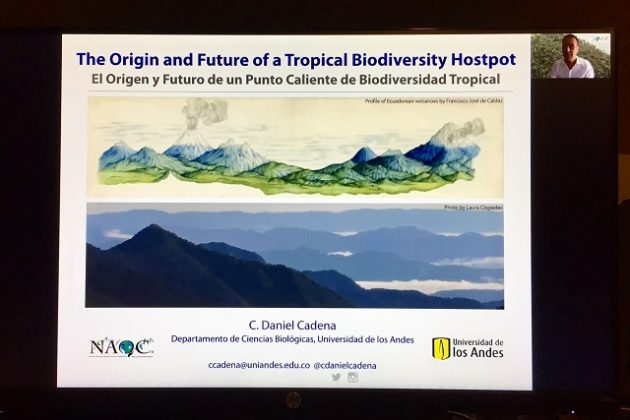
Plenary Speaker Dr. Daniel Cadena — “The Origin and Future of a Tropical Diversity Hotspot”
Beyond that, I primarily limited myself to the subject matter of hurricane impacts on birds and anything about Puerto Rico. But I also dabbled in topics such as Snowy Owl eruptions, urban ornithology, window strikes, and eBird (of course).
As one topic example, Marconi Campos-Cerqueira presented a paper entitled “Past, Current and Future Distributions of Puerto Rican Fauna: Implications from Climate Change.” He modeled likely future suitable habitats in a climate change scenario for a number of bird species of conservation concern. He then compared those habitats to protected areas, finding that much of the future habitat is currently unprotected. Thus, birds may be moving from protected areas to unprotected areas, creating a conservation mismatch. Expanded protected areas, buffer zones, and connectivity corridors may be needed to avoid local extinctions.
The symposium on hurricanes moderated by Dr. Joe Wunderle was fascinating, though sobering. Hurricanes are expected to get more frequent and severe, and particularly wetter. As Dr. Maria Uriarte indicated, that combination will likely impact Caribbean forests by repeatedly knocking down tall trees, permanently changing forest composition. For example, palms are generally more resistant to storms and over the long term, they may predominate, deferentially impacting many bird species.
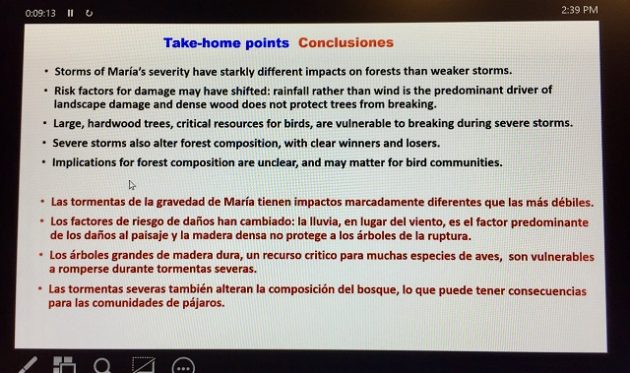
Dr. Maria Uriarte — “Impacts of Hurricane Maria on Tropical Forests: Is This the New Normal?
Dr. Tom White of the U.S. Fish and Wildlife Service talked about the devastating impact of Hurricane Maria on the wild populations of Puerto Rican Parrots. With substantial assistance, the two wild populations have now recovered to levels similar to before the hurricane. He also described the current recovery strategy for the parrot, which will involve the creation of additional populations and exchanges between them.
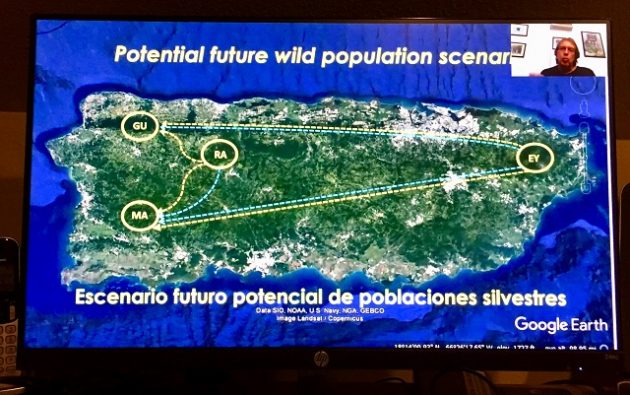
Dr. Thomas White — “Differential Hurricane Effects on Two Wild Puerto Rican Parrot Populations on Puerto Rico and Implications for Conservation and Management”
One of the panels was in honor of now-retired Dr. John Faaborg, who headed one of the key long-term studies of Caribbean birds in Guánica Commonwealth Forest in Puerto Rico. (Dr. Faaborg was the first in a line of ornithologists who have graciously responded to my emails about their research, in that case leading to a short article on declines of Puerto Rican migratory birds.)
Dr. Judith Toms did a presentation (“Long-Term Population and Community Dynamics in the Dry Forest of Guánica, Puerto Rico”) on the project, which now spans almost 50 years. Also on that panel, Dr. Loiselle presented about long-term studies in Ecuador, where there has also been a broad and significant decline in bird populations.
Additionally, you never know what might be interesting. There was an intriguing poster presentation (“What can Ornithologists Tell Us About Global Insect Decline?”) by Eliza M. Grames about how entomologists and ornithologist who research food sources for insectivores do not communicate with each other or cite the same papers despite the obvious subject matter overlap.
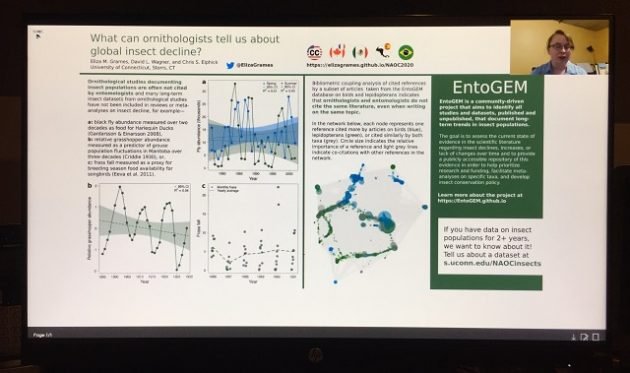
Eliza M. Grames — What can Ornithologists Tell Us About Global Insect Decline?”
Of course, my choices of presentations surely differs from others, but there are literally hundreds to choose from.
The most powerful takeaway for me, however, was not the fascinating information I learned. Rather, it was seeing a large group of dedicated and passionate professionals proposing and testing theories and generating mountains of data about birds.
They are young and old, and more diverse than I expected, perhaps because of my Caribbean subject matter choices. They approach problems in different ways using all sorts of methods, from genetics to radar to specimens to banding to mist nets, and much much more. And they are international — NAOC strongly encouraged presenters to include a translation, generally Spanish.
It is hard not to be impressed with the energy of the ornithological community and many birders will want to see it for themselves. The next NAOC will be in 2024 and hopefully there will be a virtual component. If there is, I will be “attending” again.







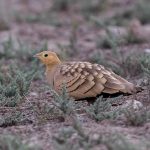





Leave a Comment